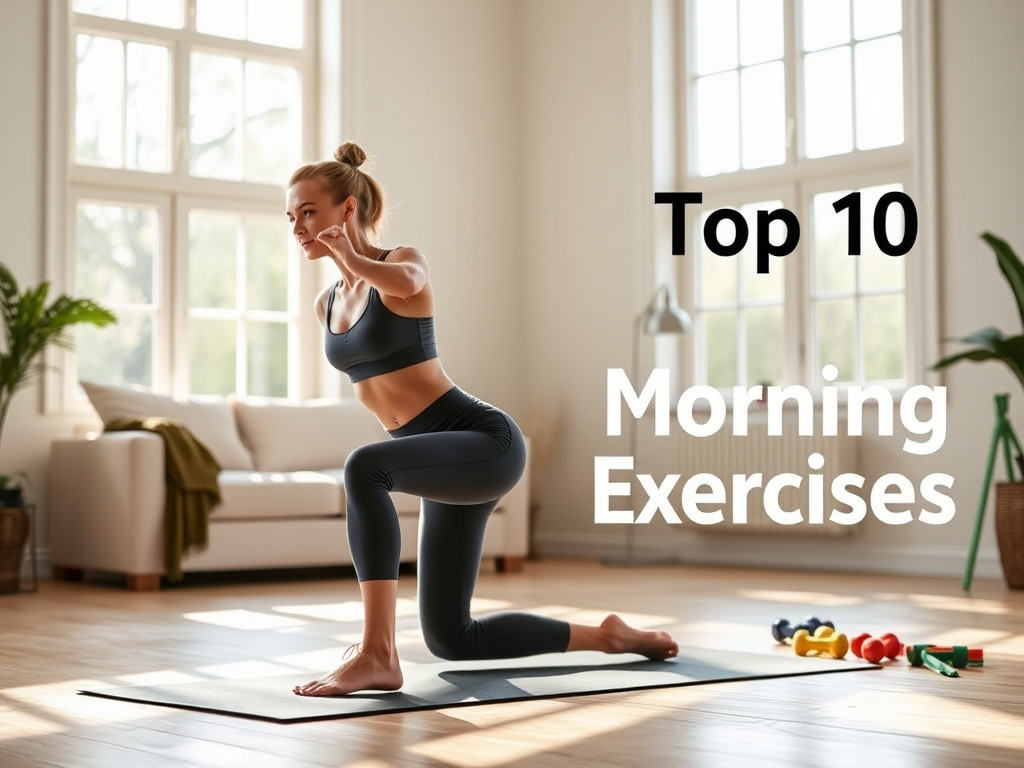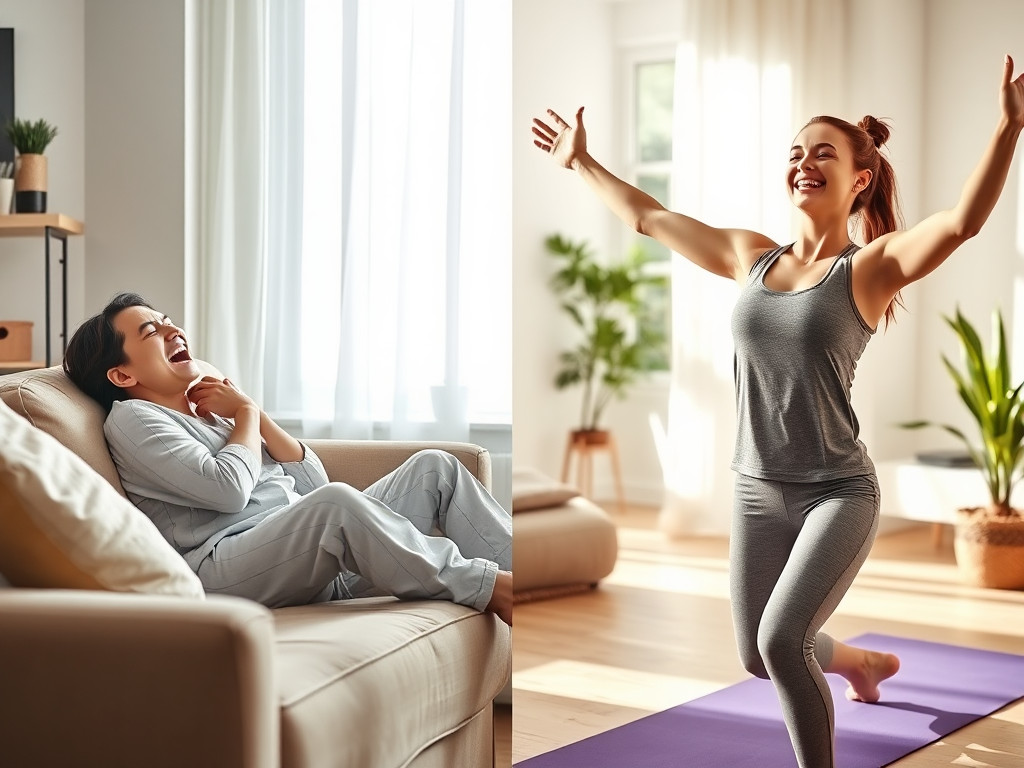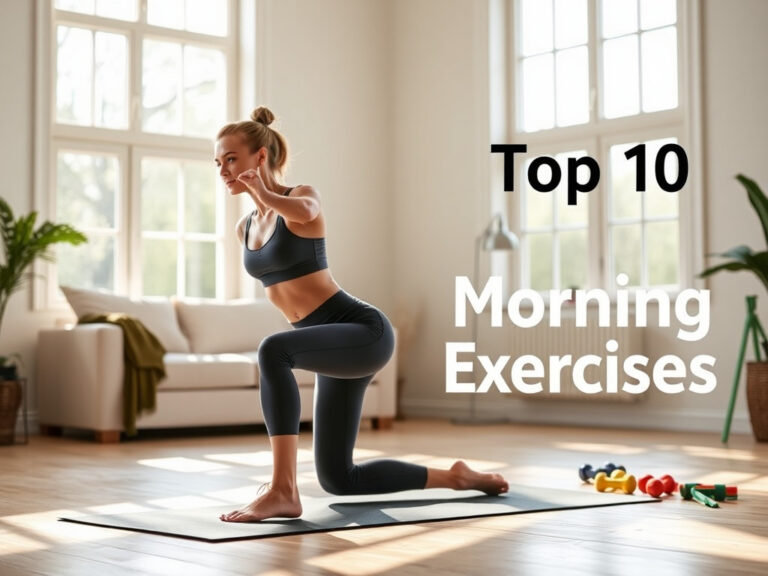
Imagine waking up feeling energized, focused, and ready to conquer the day. 🌞 Sounds like a dream, right? Well, it doesn’t have to be! The secret lies in your morning routine, specifically, incorporating exercise into those early hours. But with busy schedules and gym memberships that gather dust, how can you make this a reality?
Enter the world of home morning exercises – your ticket to a healthier, more productive life. 💪 These simple yet effective workouts can be done in the comfort of your own home, requiring little to no equipment. Whether you’re a fitness novice or a seasoned athlete, there’s something for everyone. From invigorating bodyweight exercises to calming yoga-inspired movements, we’ve curated a list of the top 10 morning exercises that will revolutionize your daily routine.
In this blog post, we’ll explore the benefits of morning exercises, guide you through essential equipment (spoiler: you don’t need much!), and provide a comprehensive list of exercises to kickstart your day. We’ll cover everything from warm-ups to cool-downs, ensuring you have all the tools to create a well-rounded, energizing morning workout. So, are you ready to transform your mornings and, by extension, your life? Let’s dive in!

Benefits of Morning Exercises
Starting your day with a morning exercise routine can have a profound impact on your overall well-being. Let’s explore the key advantages of incorporating exercise into your morning routine:
A. Improve Energy Levels
Morning exercises are a natural energy booster, helping you feel more awake and alert throughout the day. Here’s how they enhance your energy:
- Increase blood flow and oxygenation
- Stimulate the release of endorphins
- Improve overall cardiovascular function
B. Enhance Mental Clarity
Exercising in the morning can significantly improve your cognitive function and mental clarity:
- Boost concentration and focus
- Reduce mental fatigue
- Enhance problem-solving skills
C. Set a Positive Tone for the Day
Starting your day with exercise can create a positive mindset that carries through your daily activities:
- Increase self-confidence
- Reduce stress and anxiety
- Promote a sense of accomplishment
D. Boost Metabolism
Morning exercises can jumpstart your metabolism, leading to improved calorie burning throughout the day:
| Benefit | Description |
|---|---|
| Increased EPOC | Excess Post-Exercise Oxygen Consumption leads to continued calorie burn |
| Enhanced fat oxidation | Morning exercises can improve the body’s ability to burn fat |
| Improved insulin sensitivity | Regular morning workouts can help regulate blood sugar levels |
By incorporating morning exercises into your routine, you’re not just improving your physical health, but also setting yourself up for a more productive and positive day ahead. As we move forward, we’ll explore the essential equipment you’ll need to get started with your home morning exercise routine.
Essential equipment for home exercises
To get the most out of your morning workout routine, having the right equipment on hand can make a significant difference. While bodyweight exercises are excellent, a few key pieces of equipment can add variety and challenge to your workouts. Here are three essential items to consider for your home exercise routine:
A. Yoga mat
A high-quality yoga mat is a versatile piece of equipment that provides comfort and stability for various exercises. It offers the following benefits:
- Cushioning for floor exercises
- Non-slip surface for stability
- Easy to clean and maintain
- Portable for outdoor workouts
B. Resistance bands
Resistance bands are lightweight, affordable, and highly effective for strength training. They offer:
- Adjustable resistance levels
- Versatility for upper and lower body exercises
- Low impact on joints
- Easy storage and portability
C. Light dumbbells
A pair of light dumbbells can add an extra challenge to your bodyweight exercises. Consider these advantages:
- Increased muscle engagement
- Customizable weight options
- Suitable for various exercises
Here’s a comparison of these essential equipment items:
| Equipment | Portability | Versatility | Cost | Space Required |
|---|---|---|---|---|
| Yoga mat | High | Medium | Low | Minimal |
| Resistance bands | Very High | High | Low | Minimal |
| Light dumbbells | Medium | High | Medium | Small |
With these three pieces of equipment, you’ll be well-equipped to tackle a wide range of morning exercises at home. Now that we’ve covered the essential equipment, let’s move on to the importance of a proper warm-up routine to prepare your body for exercise.
Warm-up routine
Before diving into your morning exercises, it’s crucial to prepare your body with a proper warm-up routine. This will help increase blood flow, loosen up your muscles, and reduce the risk of injury. Let’s explore four essential warm-up exercises that target different parts of your body.
A. Torso twists
Torso twists are an excellent way to engage your core and increase spinal mobility. Here’s how to perform them:
- Stand with your feet shoulder-width apart
- Keep your arms relaxed at your sides
- Slowly twist your upper body from side to side
- Swing your arms gently as you twist
Aim for 10-15 twists on each side to loosen up your midsection.
B. Neck rolls
Neck rolls help relieve tension in your neck and upper shoulders. Follow these steps:
- Start with your head in a neutral position
- Slowly lower your chin to your chest
- Roll your head to the right, then back, then left, and finally forward
- Repeat the circle in the opposite direction
Perform 5-10 neck rolls in each direction, being careful not to strain your neck.
C. Arm circles
Arm circles warm up your shoulder joints and upper body. Here’s how to do them:
- Stand with your feet shoulder-width apart
- Extend your arms out to the sides at shoulder height
- Make small circular motions with your arms
- Gradually increase the size of the circles
Do 10-15 circles forward, then reverse the direction for another 10-15 repetitions.
D. Leg swings
Leg swings help improve hip mobility and warm up your lower body. Follow these instructions:
- Stand beside a wall or chair for support
- Swing one leg forward and back in a controlled manner
- Keep your upper body stable and your standing leg slightly bent
- After 10-15 swings, switch to side-to-side swings
- Repeat with the other leg
| Exercise | Repetitions | Focus Area |
|---|---|---|
| Torso twists | 10-15 each side | Core, spine |
| Neck rolls | 5-10 each direction | Neck, upper shoulders |
| Arm circles | 10-15 each direction | Shoulders, upper body |
| Leg swings | 10-15 each leg, each direction | Hips, lower body |
By incorporating these warm-up exercises into your morning routine, you’ll prepare your body for the more intense exercises to come. Remember to perform each movement slowly and controlled, focusing on proper form and breathing. Now that your body is warmed up, you’re ready to move on to the main exercises in your morning workout.
Bodyweight Exercises
Now that we’ve warmed up, let’s dive into some powerful bodyweight exercises that will kickstart your day. These exercises require no equipment, making them perfect for your morning routine at home.
A. Push-ups
Push-ups are a classic exercise that targets multiple muscle groups, including your chest, shoulders, and triceps. Here’s how to perform them correctly:
- Start in a plank position with hands shoulder-width apart
- Lower your body until your chest nearly touches the floor
- Push back up to the starting position
- Repeat for 10-15 reps
B. Squats
Squats are excellent for building lower body strength and improving core stability. Follow these steps:
- Stand with feet hip-width apart
- Lower your body as if sitting back into a chair
- Keep your chest up and weight in your heels
- Push through your heels to return to standing
- Aim for 15-20 reps
C. Lunges
Lunges help improve balance and work your legs individually. Here’s how to do them:
- Step forward with one leg
- Lower your hips until both knees are bent at 90-degree angles
- Push back to the starting position
- Alternate legs for 10-12 reps per side
D. Planks
Planks are fantastic for core strength and overall body stability. Try this:
- Start in a push-up position or on your forearms
- Keep your body in a straight line from head to heels
- Hold for 30-60 seconds
- Repeat 2-3 times
E. Mountain Climbers
Mountain climbers provide a cardio boost while working your core and legs. Here’s the technique:
- Begin in a push-up position
- Bring one knee towards your chest
- Quickly switch legs, as if running in place
- Continue for 30-45 seconds
| Exercise | Primary Muscles Worked | Recommended Reps/Time |
|---|---|---|
| Push-ups | Chest, Shoulders, Triceps | 10-15 reps |
| Squats | Quadriceps, Hamstrings, Glutes | 15-20 reps |
| Lunges | Quadriceps, Hamstrings, Glutes | 10-12 reps per leg |
| Planks | Core, Shoulders | 30-60 seconds |
| Mountain Climbers | Core, Hip Flexors, Shoulders | 30-45 seconds |
These bodyweight exercises form a solid foundation for your morning routine. As you progress, you can increase reps or add variations to keep challenging yourself. Next, we’ll explore some cardiovascular exercises to further boost your morning energy levels.
Cardiovascular exercises
Now that we’ve covered bodyweight exercises, let’s focus on some heart-pumping cardiovascular exercises you can do at home. These exercises are excellent for boosting your metabolism, improving endurance, and burning calories.
A. Burpees
Burpees are a full-body exercise that combines strength training and cardio. Here’s how to perform them:
- Start in a standing position
- Drop into a squat and place your hands on the floor
- Kick your feet back into a plank position
- Do a push-up (optional for added difficulty)
- Jump your feet back to your hands
- Explode upward with a jump, reaching your arms overhead
Aim for 3 sets of 10-15 repetitions, with 30-second rest periods between sets.
B. Jumping Jacks
Jumping jacks are a classic cardio exercise that engages your whole body:
- Start with your feet together and arms at your sides
- Jump and spread your legs while raising your arms above your head
- Jump again to return to the starting position
Try to perform 3 sets of 30 seconds each, with 15-second rest periods.
C. High Knees
High knees are great for improving coordination and cardiovascular endurance:
- Stand with your feet hip-width apart
- Run in place, lifting your knees as high as possible
- Pump your arms as you run
Aim for 3 sets of 30 seconds each, with 15-second rest periods.
| Exercise | Sets | Duration/Reps | Rest Period |
|---|---|---|---|
| Burpees | 3 | 10-15 reps | 30 seconds |
| Jumping Jacks | 3 | 30 seconds | 15 seconds |
| High Knees | 3 | 30 seconds | 15 seconds |
These cardiovascular exercises will get your heart rate up and help you burn calories efficiently. Next, we’ll explore some yoga-inspired movements to add variety to your morning routine.
Yoga-inspired movements
Now that we’ve explored some cardiovascular exercises, let’s dive into yoga-inspired movements that can elevate your morning routine. These exercises combine strength, flexibility, and mindfulness, providing a holistic approach to start your day.
Sun salutations
Sun salutations, or Surya Namaskar, are a series of flowing poses that work the entire body. This sequence is an excellent way to wake up your muscles and increase blood flow.
Benefits of Sun Salutations:
- Improves flexibility
- Boosts energy levels
- Enhances cardiovascular health
- Promotes mindfulness
Warrior poses
Warrior poses are powerful standing postures that strengthen your legs, core, and upper body while improving balance and focus.
| Pose | Primary Benefits | Muscles Targeted |
|---|---|---|
| Warrior I | Strengthens legs and core | Quadriceps, hamstrings, glutes |
| Warrior II | Improves hip flexibility | Hip flexors, shoulders, arms |
| Warrior III | Enhances balance and coordination | Back muscles, glutes, hamstrings |
Downward dog
Downward dog, or Adho Mukha Svanasana, is a foundational yoga pose that stretches and strengthens multiple muscle groups simultaneously.
Key benefits of Downward Dog:
- Lengthens the spine
- Stretches hamstrings and calves
- Strengthens arms and shoulders
- Improves blood flow to the brain
Incorporating these yoga-inspired movements into your morning routine can help you start your day feeling centered, energized, and ready to tackle whatever lies ahead. Next, we’ll explore some core strengthening exercises to further enhance your morning workout.
Core strengthening exercises
Now that we’ve explored some cardiovascular exercises, let’s focus on strengthening your core. A strong core is essential for overall body stability, improved posture, and better performance in daily activities.
A. Crunches
Crunches are a classic core exercise that primarily targets your abdominal muscles. Here’s how to perform them correctly:
- Lie on your back with knees bent and feet flat on the floor
- Place your hands behind your head, elbows pointing outward
- Lift your shoulders off the ground, engaging your core
- Lower back down with control
| Difficulty | Repetitions | Sets |
|---|---|---|
| Beginner | 10-15 | 2-3 |
| Intermediate | 15-20 | 3-4 |
| Advanced | 20-25 | 4-5 |
B. Russian twists
Russian twists are excellent for working your obliques and improving rotational strength:
- Sit on the floor with knees bent and feet lifted slightly
- Lean back slightly, keeping your back straight
- Clasp your hands together in front of your chest
- Rotate your torso from side to side, touching the floor on each side
For added difficulty, hold a small weight or water bottle in your hands.
C. Leg raises
Leg raises target your lower abdominals and hip flexors:
- Lie on your back with legs straight and arms by your sides
- Keep your lower back pressed against the floor
- Slowly lift your legs to a 90-degree angle
- Lower them back down with control, stopping just before they touch the ground
Remember to breathe steadily throughout these exercises and maintain proper form to maximize benefits and prevent injury. Next, we’ll explore some stretching exercises to complement your core workout.
Stretching exercises
Now that we’ve explored various exercises to energize your body, let’s focus on an essential component of any workout routine: stretching. Incorporating stretches into your morning routine can improve flexibility, reduce muscle tension, and prepare your body for the day ahead.
A. Shoulder stretch
The shoulder stretch is an excellent way to relieve upper body tension. Here’s how to perform it:
- Stand with your feet shoulder-width apart
- Bring your right arm across your chest
- Use your left hand to gently pull the right arm closer to your body
- Hold for 15-30 seconds, then switch arms
B. Hamstring stretch
Tight hamstrings can lead to lower back pain and reduced mobility. Try this simple hamstring stretch:
- Sit on the floor with your legs extended
- Reach for your toes, keeping your back straight
- Hold for 30 seconds, breathing deeply
- Repeat 2-3 times
C. Quad stretch
The quad stretch targets the front of your thighs and can help improve knee mobility:
- Stand near a wall or chair for balance
- Bend your right knee, bringing your heel towards your buttocks
- Grasp your right foot with your right hand
- Hold for 15-30 seconds, then switch legs
D. Lower back stretch
Relieve tension in your lower back with this gentle stretch:
- Lie on your back with your knees bent
- Slowly bring both knees to your chest
- Wrap your arms around your legs
- Hold for 30 seconds, then release
| Stretch | Main Benefits | Duration |
|---|---|---|
| Shoulder | Relieves upper body tension | 15-30 seconds per arm |
| Hamstring | Improves lower back flexibility | 30 seconds, 2-3 repetitions |
| Quad | Enhances knee mobility | 15-30 seconds per leg |
| Lower back | Alleviates lower back tension | 30 seconds |
Remember to breathe deeply and never force a stretch beyond your comfort level. These stretches can be performed daily to maintain flexibility and reduce the risk of injury in your other morning exercises.
Next, we’ll explore the importance of a proper cool-down routine to complete your morning workout effectively.
Cool-down routine
As we wrap up our invigorating morning workout, it’s crucial to include a proper cool-down routine. This final phase helps your body transition from high-intensity activity to a resting state, promoting recovery and reducing the risk of injury.
A. Deep breathing exercises
Start your cool-down with deep breathing exercises to calm your mind and regulate your heart rate:
- Inhale deeply through your nose for 4 counts
- Hold your breath for 4 counts
- Exhale slowly through your mouth for 6 counts
- Repeat 5-10 times
B. Light walking in place
Continue cooling down by walking in place for 2-3 minutes. This gentle movement helps:
- Gradually lower your heart rate
- Prevent blood from pooling in your legs
- Maintain circulation throughout your body
C. Gentle stretches
Finish your cool-down routine with these gentle stretches, holding each for 15-30 seconds:
| Stretch | Muscles targeted | Technique |
|---|---|---|
| Standing quad stretch | Quadriceps | Hold one foot behind your back, keeping knees together |
| Forward fold | Hamstrings, lower back | Bend forward from the hips, keeping a slight bend in knees |
| Chest opener | Chest, shoulders | Clasp hands behind back, lift arms and open chest |
| Neck rolls | Neck, upper trapezius | Slowly roll head in a circular motion, both directions |
Remember to breathe deeply and avoid bouncing or forcing the stretches. This cool-down routine will help you feel refreshed and ready to tackle your day ahead.
Tips for maintaining consistency
Establishing a consistent morning exercise routine can be challenging, but with the right strategies, you can make it a lasting habit. Here are some effective tips to help you maintain consistency in your home workout regimen:
A. Set realistic goals
Setting achievable goals is crucial for long-term success. Start small and gradually increase the intensity and duration of your workouts. Here’s a simple goal-setting framework:
- Short-term goals (1-2 weeks)
- Medium-term goals (1-3 months)
- Long-term goals (6 months to 1 year)
| Goal Type | Example |
|---|---|
| Short-term | Exercise for 15 minutes, 3 days a week |
| Medium-term | Increase workout duration to 30 minutes, 5 days a week |
| Long-term | Complete a 5K run or master advanced yoga poses |
B. Create a schedule
Integrate your morning exercises into your daily routine by creating a consistent schedule. This helps form a habit and makes it easier to stick to your workout plan.
- Choose a specific time for your workouts
- Set reminders on your phone or smartwatch
- Prepare your workout clothes and equipment the night before
C. Track progress
Monitoring your progress can be a powerful motivator. Use these methods to keep track of your fitness journey:
- Fitness apps or smartwatches
- Workout journals
- Progress photos
- Performance metrics (e.g., number of repetitions, weight lifted)
D. Mix up routines
Variety is key to preventing boredom and maintaining enthusiasm for your morning exercises. Try these strategies to keep your workouts fresh and engaging:
- Alternate between different types of exercises (e.g., cardio, strength training, yoga)
- Experiment with new workout videos or apps
- Challenge yourself with themed workout weeks
- Invite friends or family members to join you occasionally
By implementing these tips, you’ll be well on your way to establishing a consistent and enjoyable morning exercise routine at home. Remember, consistency is more important than perfection, so focus on making your workouts a regular part of your daily life.


